📚 Language Evolution: Essential Concepts for Reading Comprehension
Language evolution examines how languages develop, change, and influence one another over time. It explores the origins of languages, the processes behind linguistic change, and the cultural contexts that shape communication. RC passages on this topic often analyze linguistic theories, historical developments, and the interplay between language and society. Understanding these concepts provides insights into how languages connect cultures and adapt to human needs.
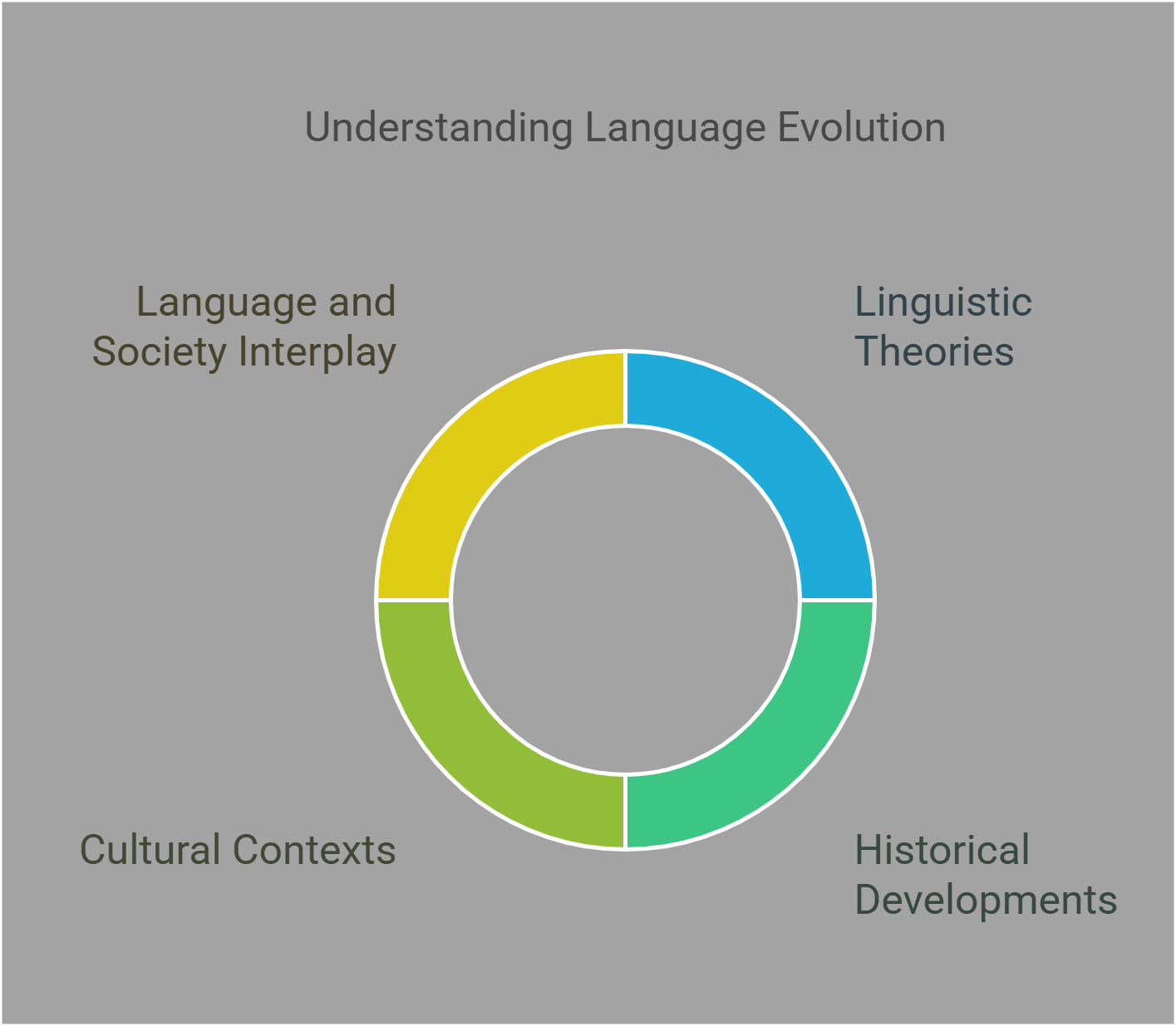
📋 Overview
This guide explores the following essential concepts in language evolution:
- Proto-Indo-European Language
- Language Family Trees
- Evolution of Writing Systems
- Language Isolates
- Language Death and Revitalization
- The Role of Borrowed Words
- Sound Shifts in Language Change
- Origins of Grammar Systems
- Creole Formation Theories
- The Sapir-Whorf Hypothesis
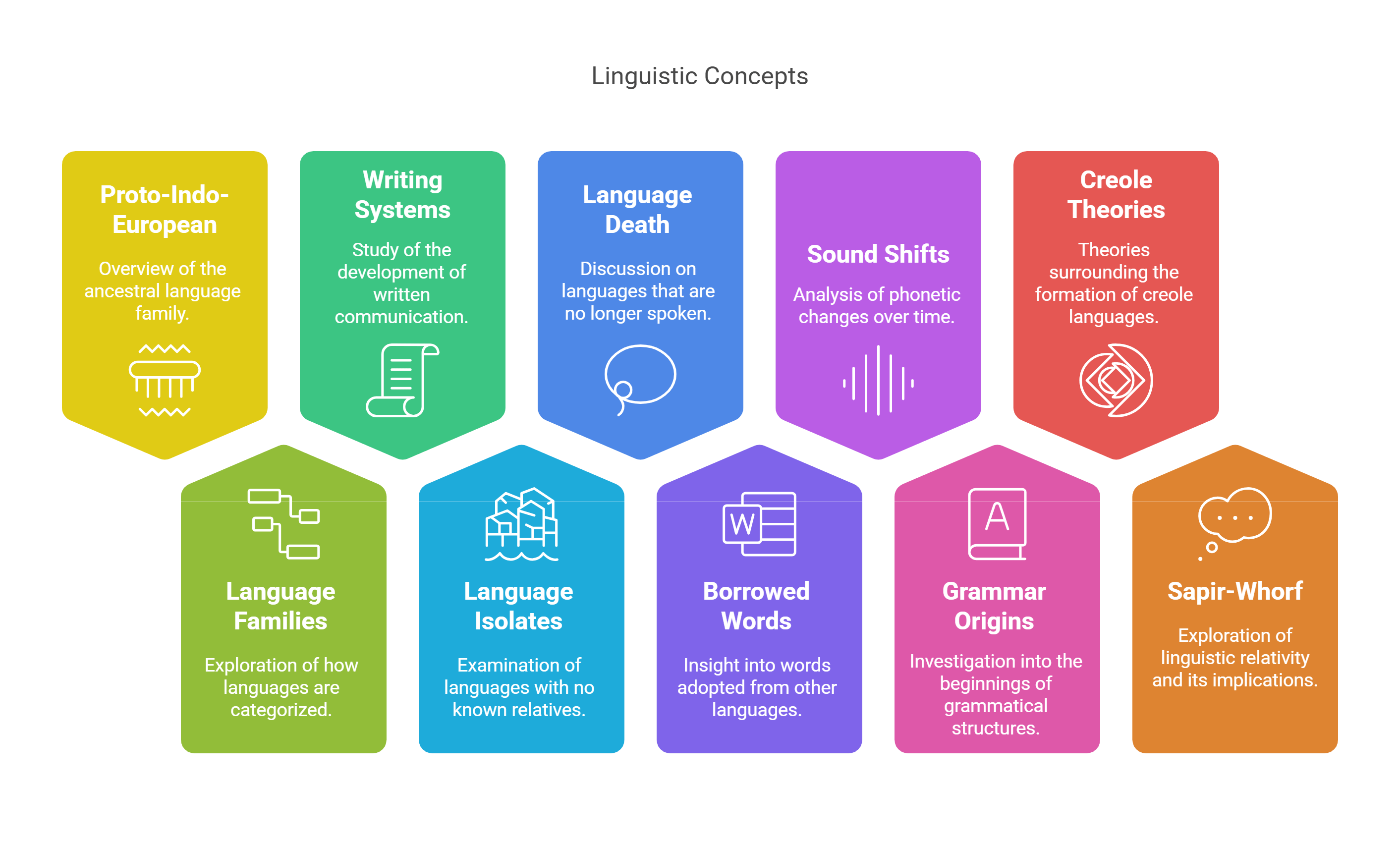
🔍 Detailed Explanations
1. Proto-Indo-European Language
Proto-Indo-European (PIE) is the hypothesized common ancestor of the Indo-European language family, spoken by a prehistoric population that lived approximately 4,500–6,000 years ago. While PIE was never written down, linguists have reconstructed its structure and vocabulary by comparing similarities across descendant languages.
- Vocabulary: Terms for basic concepts such as family (pater for father) and nature (akwā for water) indicate common cultural and environmental elements.
- Grammar: PIE had a complex system of noun cases, verb conjugations, and word order.
- Phonology: Included sounds like aspirated stops and pitch accent, reflected in languages like Sanskrit and Ancient Greek.
Descendant Families:
- Germanic Languages: English, German, and Dutch.
- Romance Languages: French, Spanish, and Italian.
- Indo-Iranian Languages: Hindi, Persian, and Kurdish.
Importance: Reconstructing PIE helps linguists trace human migration patterns, cultural exchanges, and historical interactions between civilizations.
Explained Simply: PIE is like the linguistic root of a vast family tree, branching out into many of the languages spoken today.
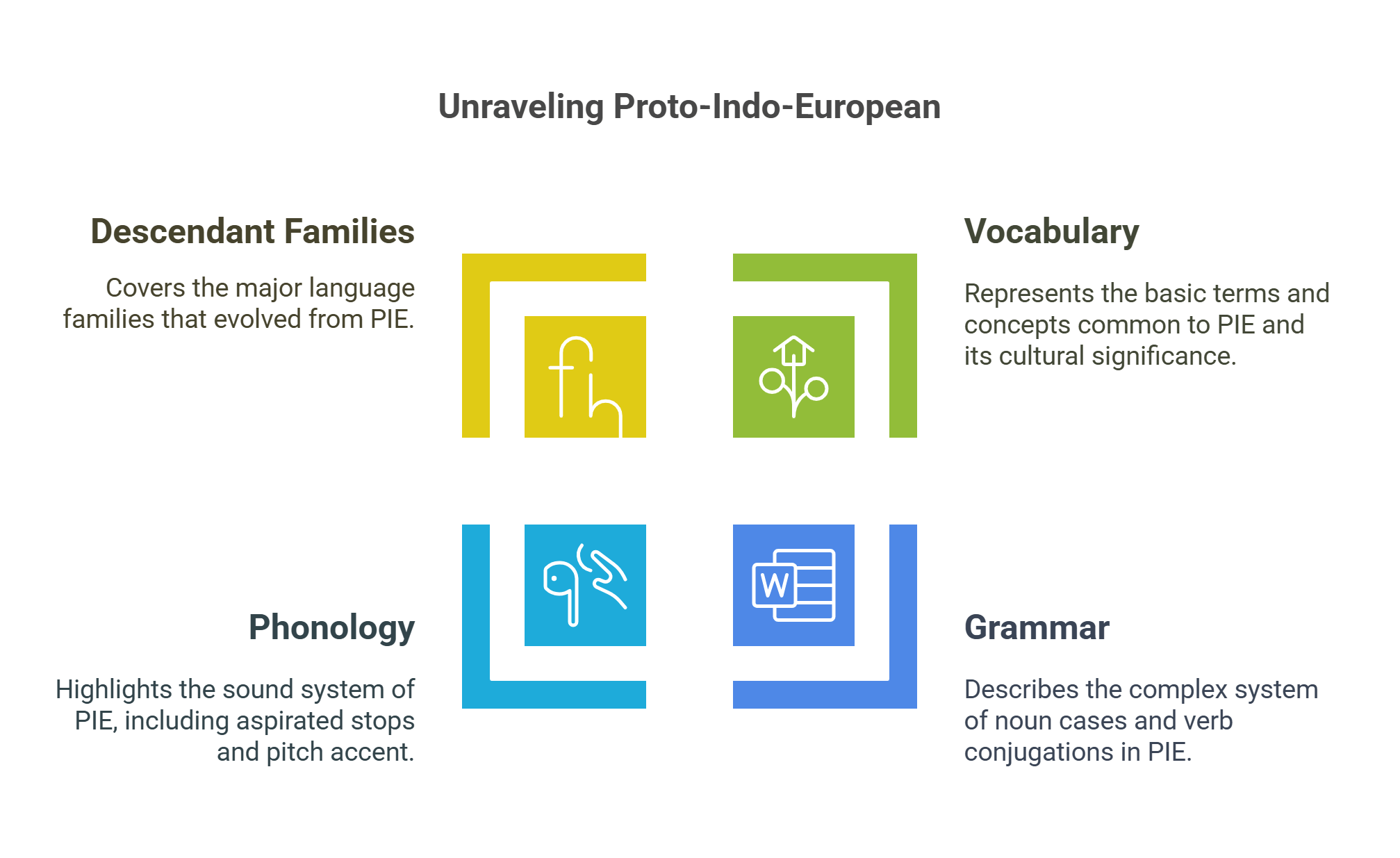
2. Language Family Trees
Language family trees visually represent the relationships between languages, grouping them based on their descent from common ancestors. These trees illustrate how languages evolve, split, and diversify over time.
- Structure of a Language Family Tree:
- Root: Represents a proto-language like PIE, the source of the family.
- Branches: Represent language groups or subfamilies (e.g., Slavic, Germanic).
- Leaves: Individual languages like Russian, English, or Italian.
- Applications:
- Understanding historical linguistics and tracing cultural connections.
- Mapping human migrations based on linguistic diffusion.
Example: The Indo-European tree includes Germanic languages (English, German), Romance languages (Spanish, French), and Indo-Aryan languages (Hindi, Bengali).
Explained Simply: Language family trees are like genealogies for languages, showing how they’re “related” through shared ancestors.
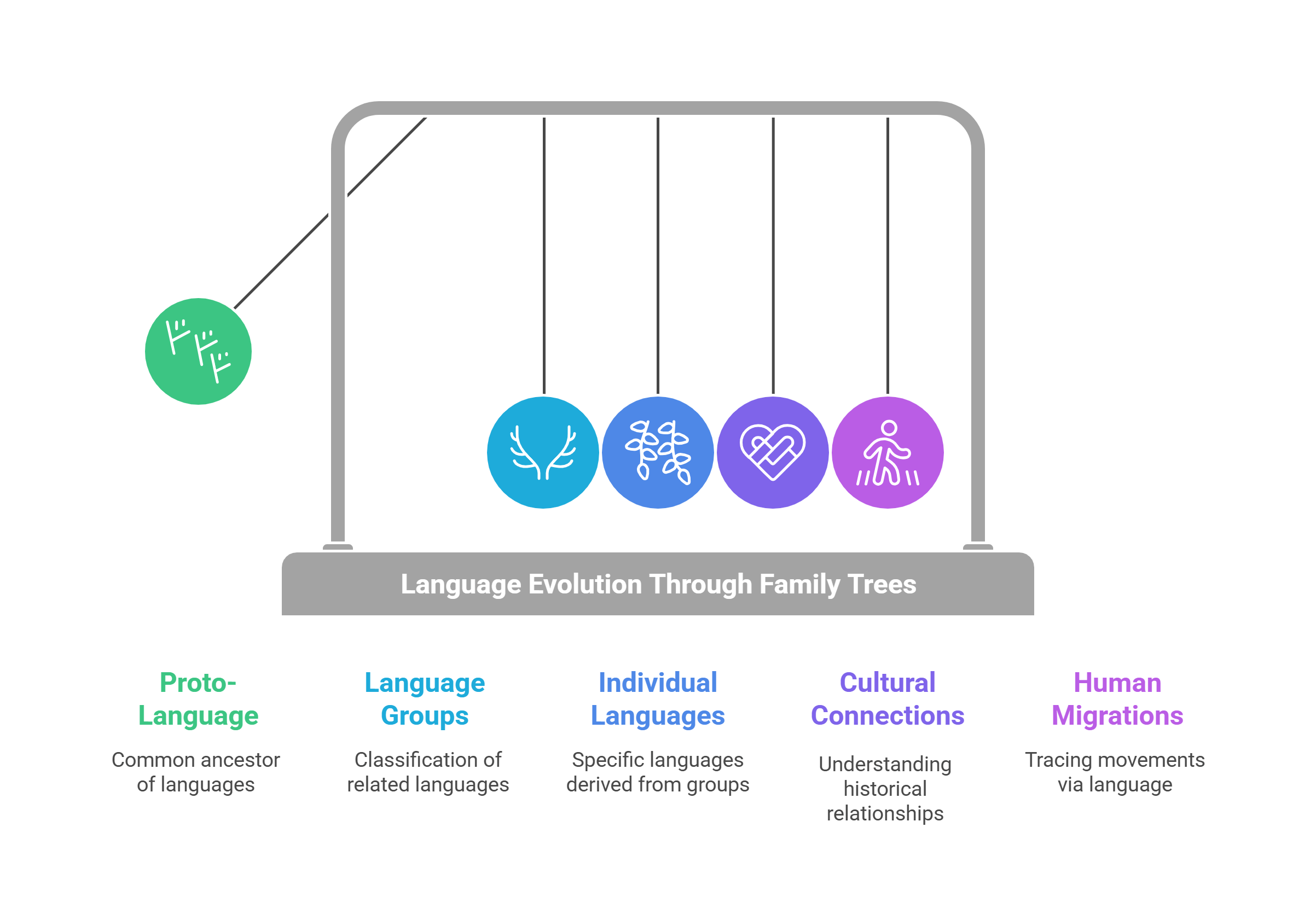
3. Evolution of Writing Systems
Writing systems evolved as a way to preserve and transmit language over time, enabling communication across generations and distances. They developed from simple symbols to complex scripts.
- Major Stages of Development:
- Pictograms: Early symbols representing objects or ideas (e.g., cave paintings, Sumerian cuneiform).
- Logograms: Symbols representing entire words or concepts (e.g., Chinese characters).
- Syllabaries: Systems where symbols represent syllables (e.g., Japanese kana).
- Alphabetic Systems: Letters representing individual sounds, as in the Latin or Greek alphabets.
- Impact on Civilization:
- Facilitated record-keeping, administration, and the development of literature.
- Standardized languages, ensuring their survival and consistency.
Example: The Phoenician alphabet influenced the Greek alphabet, which in turn became the basis for the Latin script used today.
Explained Simply: Writing systems are like tools for turning spoken words into durable records, preserving knowledge through time.
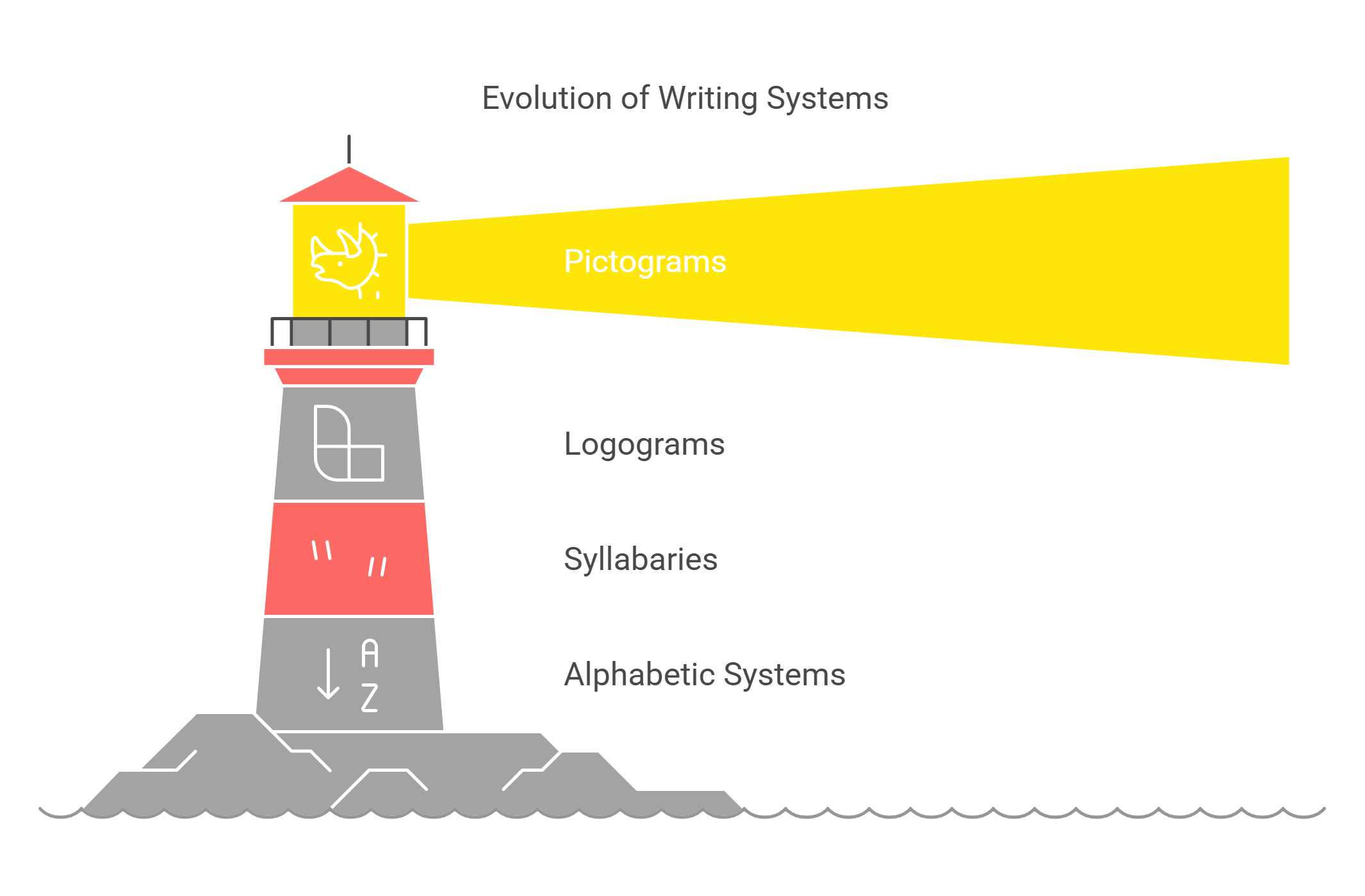
4. Language Isolates
Language isolates are unique languages that have no known relatives or connections to any existing language family. These languages are often remnants of ancient linguistic traditions that survived independently.
- Examples of Language Isolates:
- Basque: Spoken in northern Spain and southwestern France, it predates the arrival of Indo-European languages in Europe.
- Ainu: An Indigenous language of Japan, unrelated to Japanese or other East Asian languages.
- Korean: While some linguists argue it has distant connections to other languages, it is often treated as an isolate.
- Significance:
- Offer unique insights into human history and migration patterns.
- Often endangered, requiring urgent preservation efforts to maintain linguistic diversity.
Explained Simply: Language isolates are like linguistic islands, standing alone in a sea of related languages.
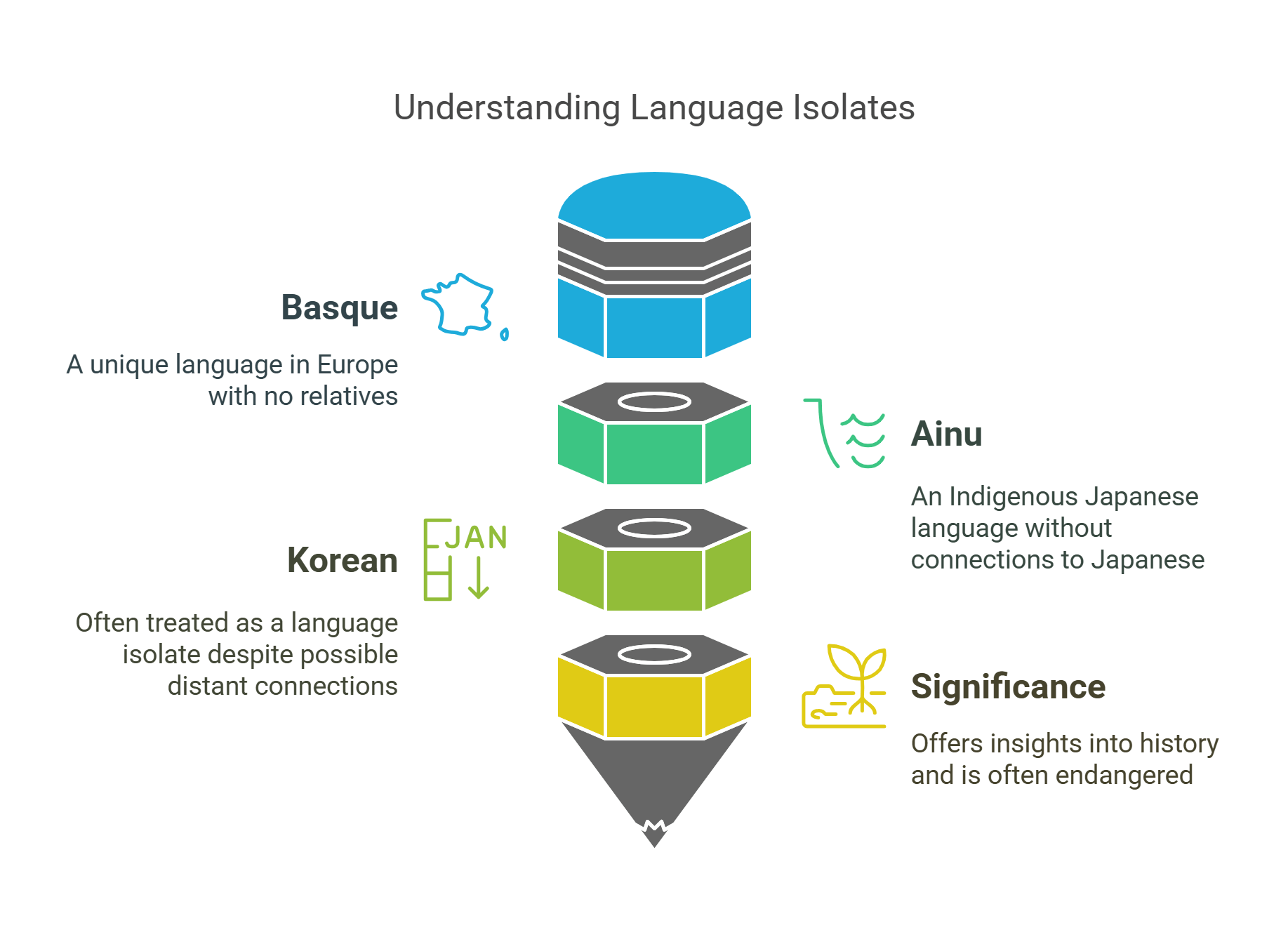
5. Language Death and Revitalization
Language death occurs when a language loses its last native speakers, often due to cultural assimilation, economic pressures, or the dominance of global languages like English or Spanish. Revitalization efforts aim to preserve or revive these endangered languages.
- Causes of Language Death:
- Colonization and forced assimilation, as seen with Indigenous languages in the Americas.
- Economic and social pressures that favor dominant languages for education or employment.
- Strategies for Revitalization:
- Education: Immersion schools that teach children endangered languages.
- Media: Creating literature, music, and digital content in the language.
- Documentation: Recording native speakers for linguistic study and preservation.
Example: Hawaiian has been revitalized through immersion programs, cultural initiatives, and state recognition as an official language.
Explained Simply: Language death is like extinguishing a flame, but revitalization rekindles it, keeping cultural stories alive.
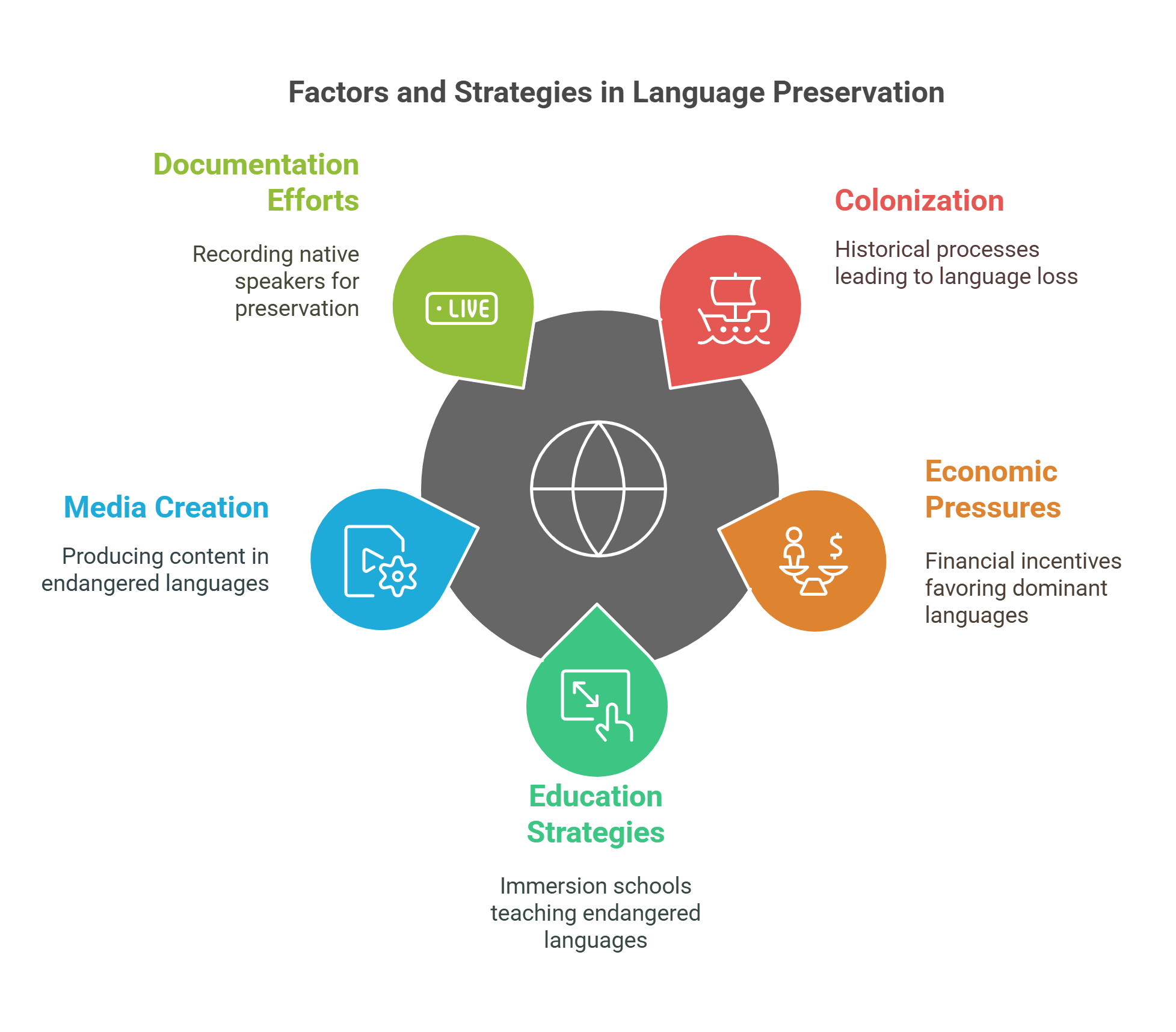
6. The Role of Borrowed Words
Borrowed words, also known as loanwords, are terms adopted from one language into another due to cultural contact, trade, conquest, or technological advancement. Borrowing enriches a language’s vocabulary, reflecting historical interactions and evolving cultural dynamics.
- Types of Borrowing:
- Direct Borrowing: Words taken with minimal changes (e.g., piano from Italian into English).
- Calques: Phrases translated word-for-word into another language (e.g., flea market from French marché aux puces).
- Adapted Borrowing: Words modified to fit the phonetic or grammatical system of the borrowing language (e.g., restaurant in English from French).
- Impact on Language Evolution:
- Enhances lexical diversity, allowing languages to adapt to new ideas or technologies.
- Reflects cultural exchange and historical events (e.g., Arabic words in Spanish due to the Moorish presence in Iberia).
Example: English has borrowed extensively from French (ballet), Latin (agenda), and Hindi (jungle).
Explained Simply: Borrowed words are like souvenirs from cultural exchanges, enriching languages with new concepts and expressions.
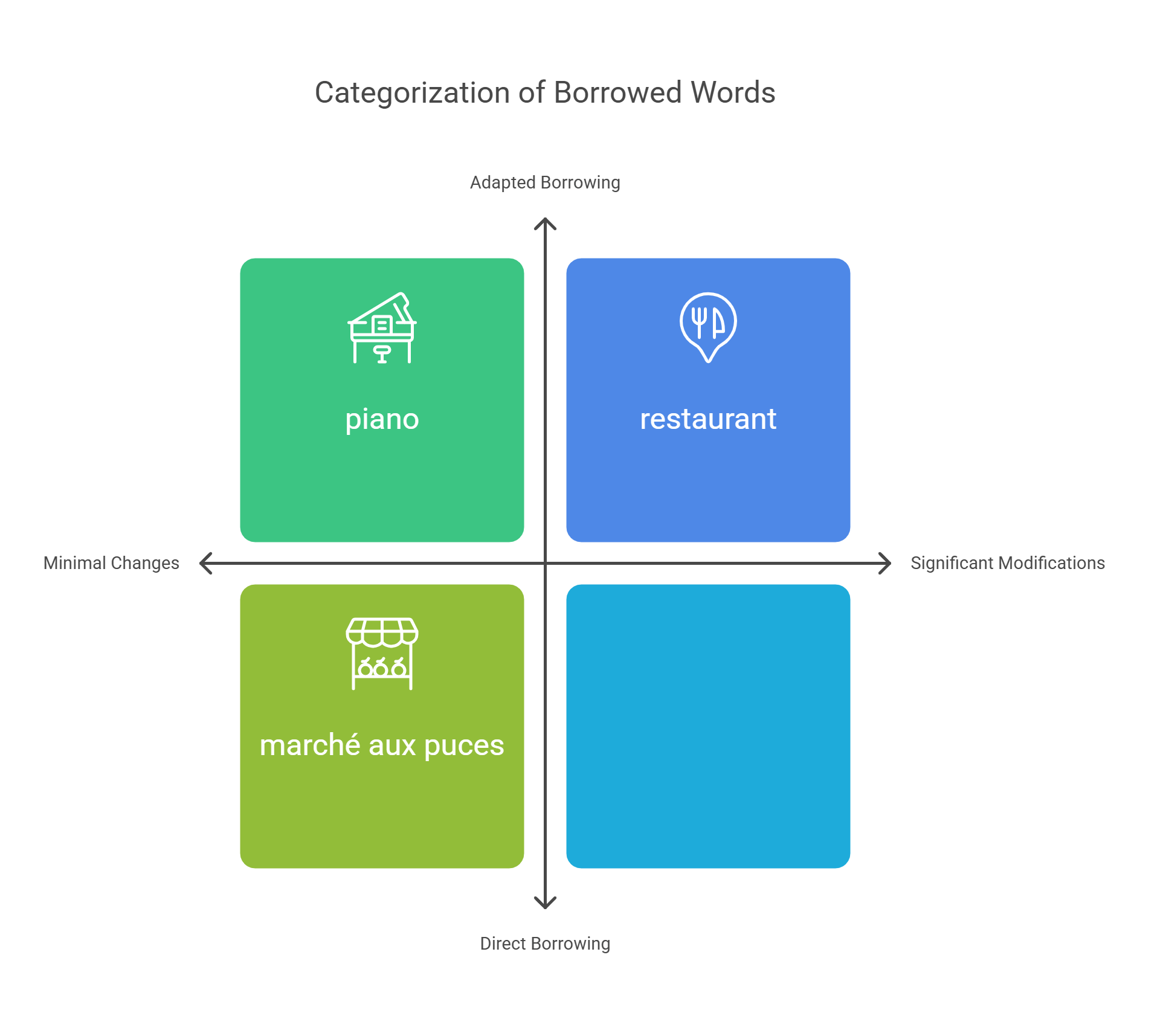
7. Sound Shifts in Language Change
Sound shifts are systematic changes in pronunciation that occur over time in a language, often leading to the divergence of dialects or the emergence of new languages. These changes are key indicators of linguistic evolution.
- Types of Sound Shifts:
- Vowel Shifts: Changes in vowel pronunciation, such as the Great Vowel Shift in English, which transformed words like name (pronounced nah-meh in Middle English) into their modern forms.
- Consonant Shifts: Alterations in consonant sounds, as seen in the Germanic sound shift (p to f, as in Latin pater vs. English father).
- Impact:
- Can make older forms of a language unintelligible to modern speakers.
- Drives the formation of new languages from a common ancestor (e.g., Latin evolving into the Romance languages).
Example: The Indo-European k sound became an h sound in English (e.g., Latin cord to English heart).
Explained Simply: Sound shifts are like the linguistic equivalent of natural erosion, gradually reshaping words over time.
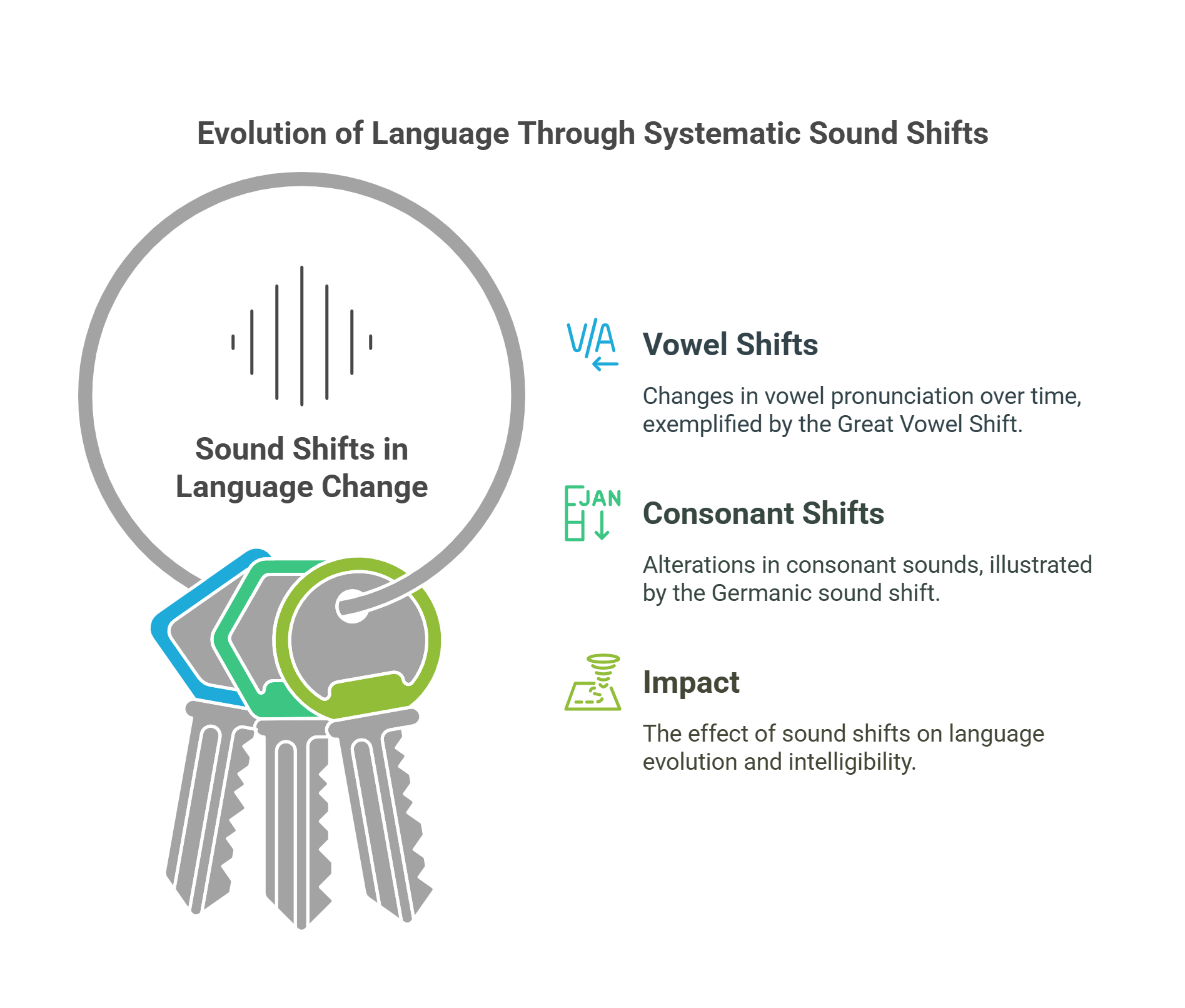
8. Origins of Grammar Systems
Grammar systems govern the structure of a language, including word order, sentence construction, and agreement between elements. They evolve naturally as languages adapt to the needs of their speakers.
- Key Aspects of Grammar:
- Syntax: Rules for arranging words into sentences (e.g., Subject-Verb-Object in English).
- Morphology: Rules for forming words, such as adding prefixes or suffixes.
- Phonology: Patterns of sounds and their roles in language.
- Theories on Grammar Evolution:
- Innate Theory: Noam Chomsky’s concept of a “universal grammar,” suggesting humans are biologically predisposed to learn grammar.
- Cultural Adaptation Theory: Proposes that grammar develops through usage and cultural evolution.
Example: English uses auxiliary verbs for questions (“Did you go?”), while Chinese relies on word order alone.
Explained Simply: Grammar systems are like the operating instructions for a language, shaping how ideas are expressed and understood.
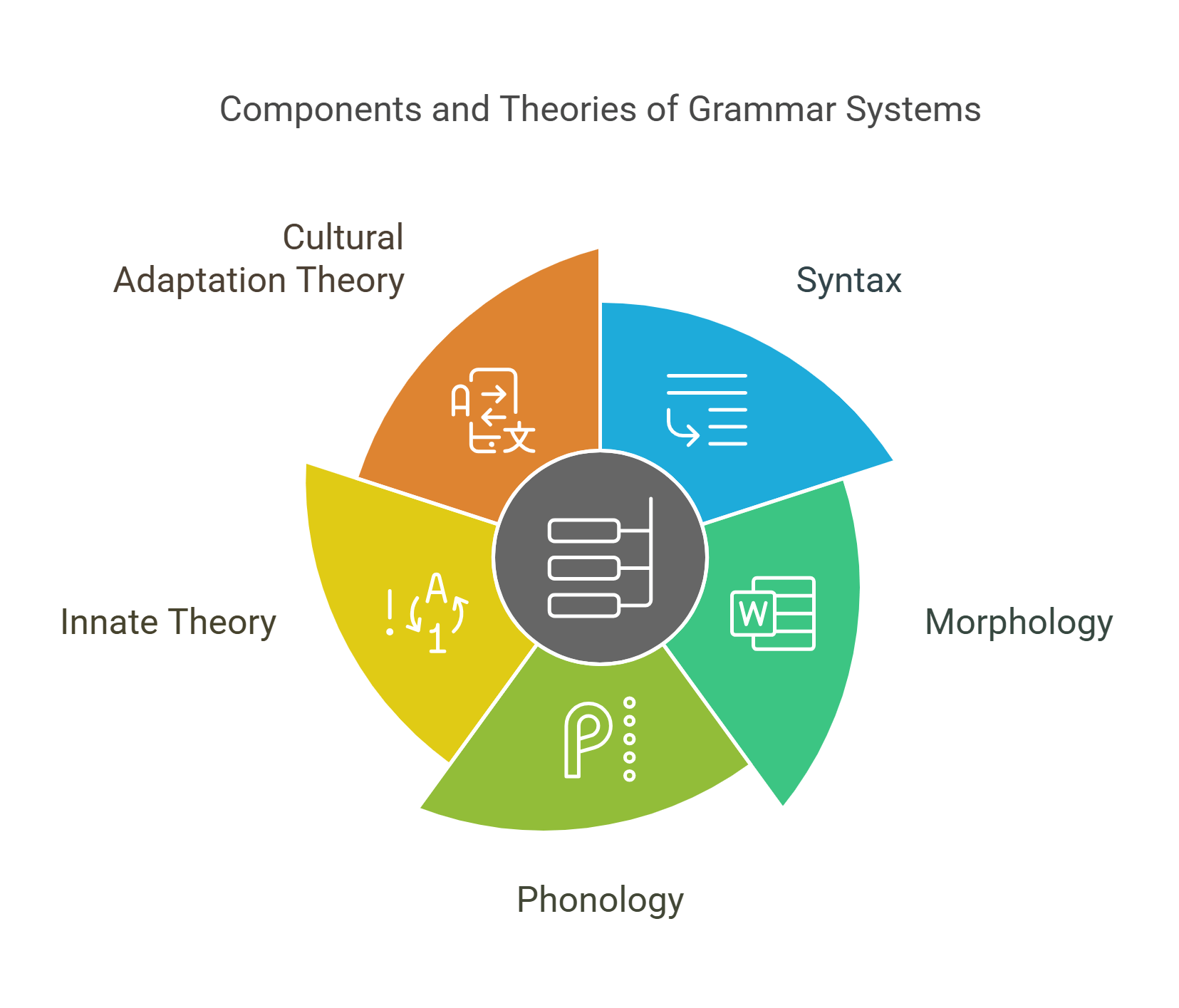
9. Creole Formation Theories
Creoles are fully developed languages that emerge from the blending of two or more languages, often in contexts like colonization, trade, or migration. They evolve from pidgins (simplified languages) used for basic communication into complex, stable languages over generations.
- Stages of Creole Development:
- Pidgin Stage: Simplified grammar and vocabulary used for trade or communication.
- Creolization: Expansion of vocabulary and grammar as the language becomes a native tongue.
- Key Theories:
- Substrate Theory: Creoles retain grammatical features from the native languages of their speakers.
- Universalist Theory: Creoles reflect universal principles of language development.
Examples:
- Haitian Creole (based on French and African languages).
- Tok Pisin (based on English and Indigenous languages of Papua New Guinea).
Explained Simply: Creoles are like linguistic hybrids, blending elements from parent languages to form something entirely new.
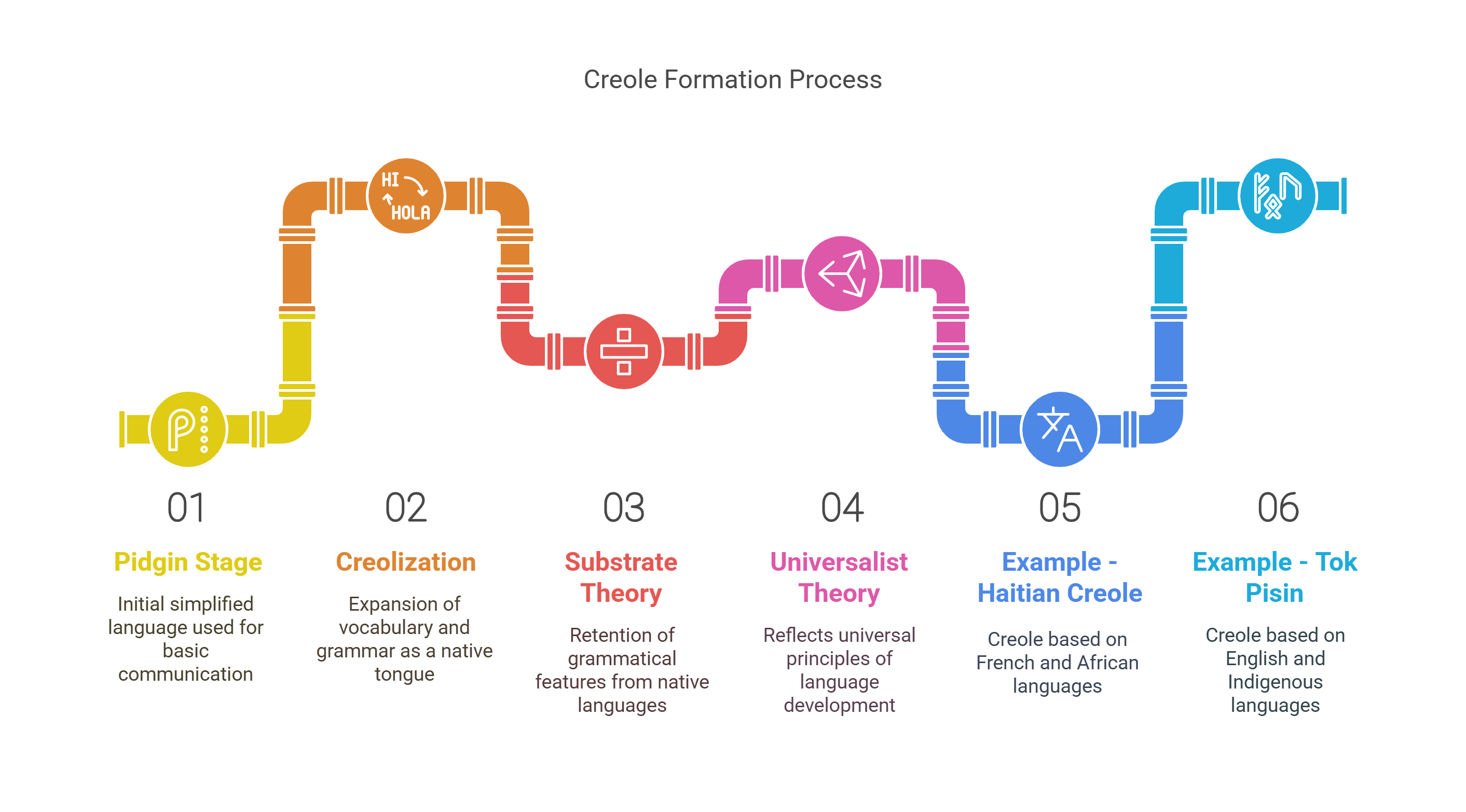
10. The Sapir-Whorf Hypothesis
The Sapir-Whorf Hypothesis, also known as linguistic relativity, suggests that the structure of a language influences how its speakers perceive and think about the world.
- Two Versions:
- Strong Version (Linguistic Determinism): Language determines thought, meaning speakers of different languages experience reality differently.
- Weak Version (Linguistic Relativity): Language shapes, but does not restrict, thought.
- Examples of Linguistic Influence:
- Color Perception: Languages with fewer color terms may group colors differently (e.g., some Indigenous languages have a single word for blue and green).
- Time and Space: English speakers view time linearly, while Hopi speakers describe it cyclically.
Impact: Sparks debates in cognitive science, anthropology, and philosophy about the interplay between language and thought.
Explained Simply: The Sapir-Whorf Hypothesis is like a pair of tinted glasses—your language colors the way you see the world.
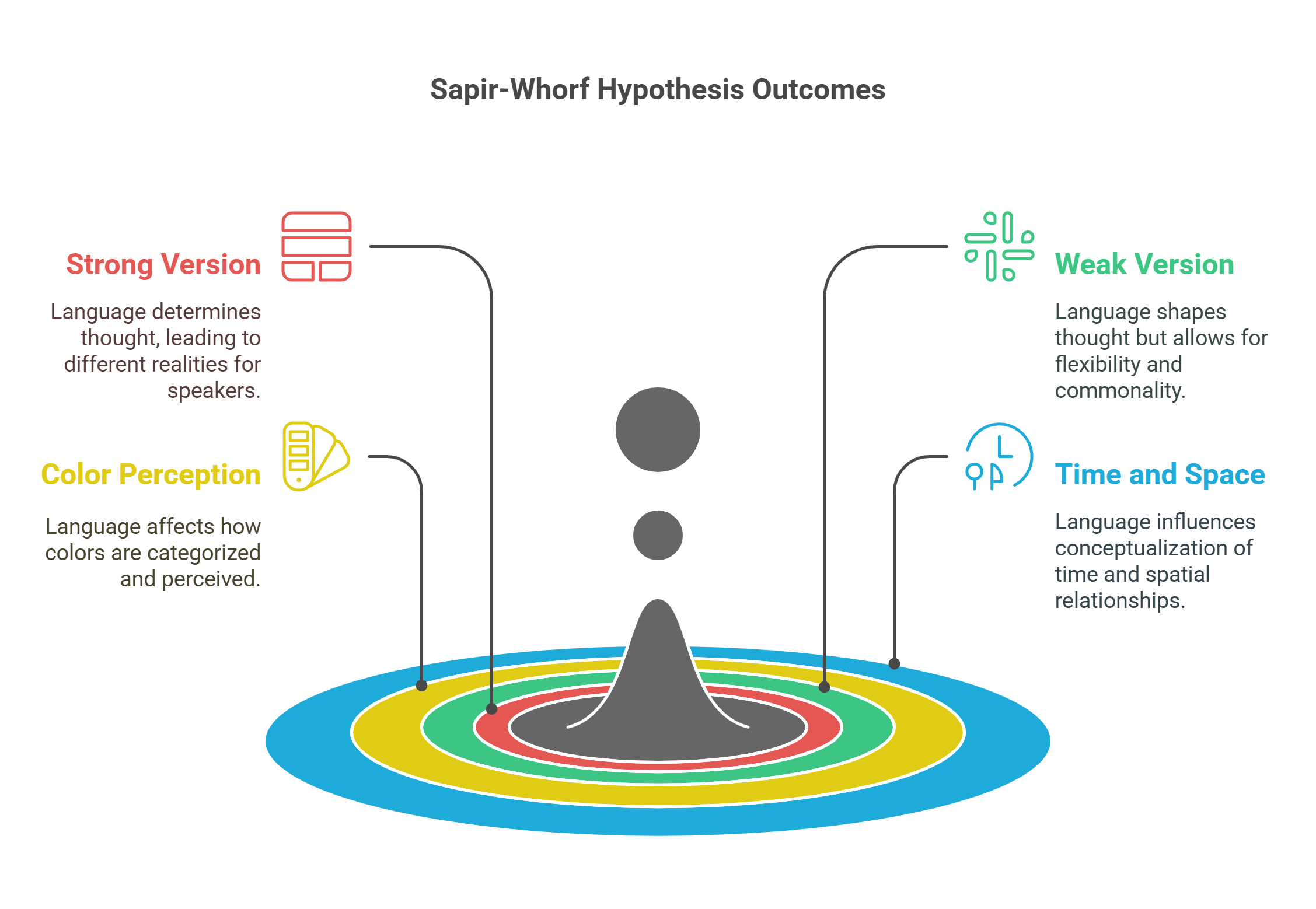
✨ Conclusion
Language evolution offers a fascinating lens into how humans communicate, adapt, and preserve their cultures. By exploring topics like sound shifts, borrowed words, and the Sapir-Whorf Hypothesis, readers can critically engage with RC passages on linguistic development and appreciate the intricate dynamics of human expression.












